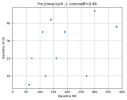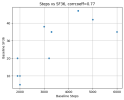I’m a bit late to some of the detail of this paper but some questions I had which seem relevant to the current discussion
When is the assumption made that ADCC and NK is important (Daratumumab seems to have other mechanisms of action)? Why is there an assumption of autoantibodies being involved?
If we assume there is a feedback loop of some sort with various factors involved and this is only one leg being kicked out, should we focus on that one leg?Correlation is not causation after all so what about the influence of other, non measured factors which may support this loop?
Could the non-responders have been in PEM or had another perpetuating effect and therefore their body wasn't able to ‘recover’ or ‘reset’ during this initial dosing period. For instance how far did the different patients meed to travel? Maybe some had minor infections? Maybe some were just unlucky with which cells were hit and some cells were at different points in their lifecycle so topped up a pool of perpetuating cells? Etc
There seems to be many factors which may be involved here that I’m unsure why NK cells is being focused on other than, well, because it was measured. So I’m just a bit sceptical at this point that we can really know what’s going on given so many unknowns. Building a hypothesis is obviously useful, but thinking about other factors may be important for understanding what happens in this larger trial, especially if the assumptions being made are wrong.


